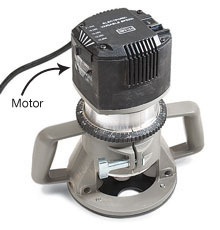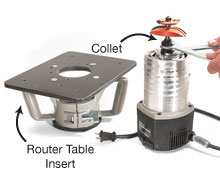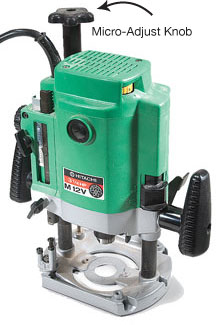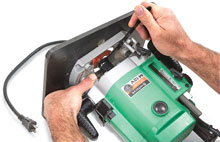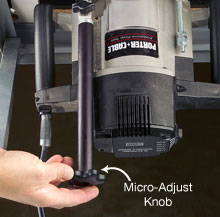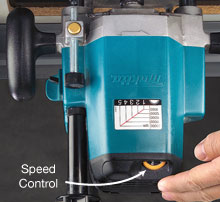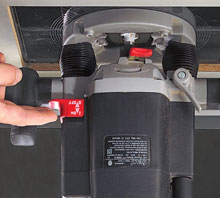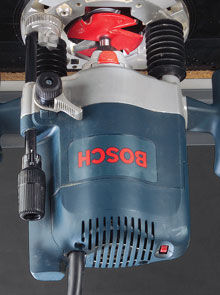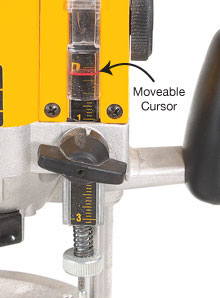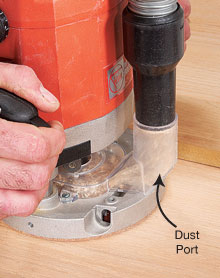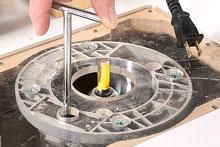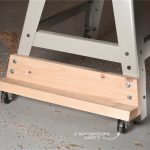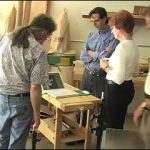We may receive a commission when you use our affiliate links. However, this does not impact our recommendations.
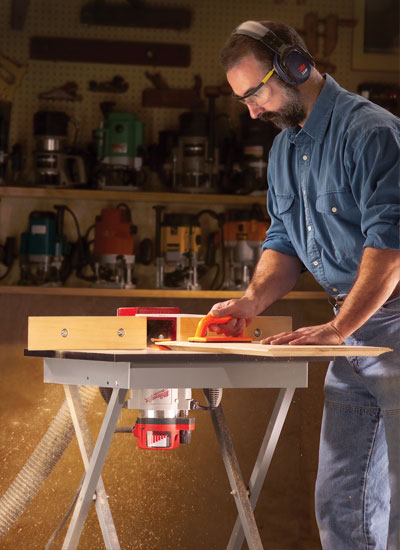
What's the one thing you need most when you're shaping dozens of raised panels on a router table? Power! These 3-hp monsters deliver plenty. There are two completely different kinds of 3-hp routers: fixed-base and plunge. Both types have 15-amp motors with variable speed (a must for big bits), soft start (so your arm isn't wrenched when turning the machine on in a hand-held cut) and feed back circuitry (which helps the motor maintain rpm as it bears into a heavy cut). There's a huge difference between fixed-base and plunge routers, however, in how easy they are to use in a router table. Adjusting some of these big routers can be a real headache. Few of them have been specifically designed to be used upside down in a router table, but some manufacturers are clearly catching on.
Fixed-Base Routers
A fixed-base router is our first choice for use in a router table. It has two distinct advantages: it's easy to change a bit quickly and it's easy to adjust the bit's height. Making a coarse height adjustment is a simple matter of loosening a clamping mechanism and twisting or lifting the router's motor (Photo 1). To change bits, all you have to do is remove the router motor from the base (Photo 2). The collet is right out in the open.
|
PHOTO 1: |
PHOTO 2: |
Plunge Routers
A powerful plunge router is a great tool for cutting large dadoes and mortises, but the features that make it handy for hand-held work get in the way when you hang the machine in a router table (Photo 3). Adjusting the bit height is awkward on most plunge routers because there's no coarse height adjustment. Instead, you end up turning and turning a micro-adjust knob. Changing bits can be even more of a hassle, particularly when the bit has a large diameter, like a panel-raiser (Photo 4).
|
PHOTO 3: |
PHOTO 4: |
Router Table-Friendly Feature
Discombobulating problems crop up when you turn a router upside down and tuck it under a router table. Labels are difficult to read. Switches are backwards. Whether you choose a fixed-base or a plunge router for your router table, here are some features that make any machine safer and easier to use. Unfortunately, there are only two 3-hp fixed-base routers on the market. The Porter-Cable 7518 has been around for quite a while, and was our Editors' Choice when we last tested 3-hp routers in AW #78, February, 2000. The new Milwaukee 5625-20 is even better. Both routers pack plenty of power, but the Milwaukee is easier to adjust in a router table.
|
PHOTO 5: |
PHOTO 6: |
|
PHOTO 7: |
PHOTO 8: |
You Should Also Know About… Mid-Sized Combo Kits
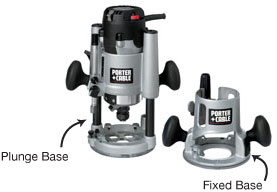
A 15-amp, 3-hp router isn't the only good choice for a router table. Mid-sized routers with 12-amp, 1-1/2- to 2-hp motors work perfectly well for light-duty jobs and occasional raised panel work. Our favorite routers in this category are combo kits. For about the same price as one of the less expensive 3-hp routers ($220 to $250), you get one motor that fits a fixed base and a plunge base. You can have the best of both worlds by leaving the fixed base in the router table and using the plunge base for virtually all hand-held work. For more about combo kits, see our Tool Test in AW #99, March 2003, page 64, or go to www.americanwoodworker.com.
Plunge Routers Off the Table
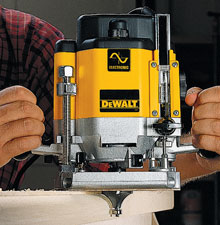
Our favorite 3-hp router for a router table is a fixed-base machine, but when you want to stretch your tool dollars as far as they'll go, a big plunge router makes a lot of sense. You can't make stopped dadoes and mortises with a fixed-base router, after all. Out of the table, a 3-hp plunge router is large and heavy (most weigh 12 to 13 lbs.), but it's a great machine to drive big bits. Take a wide roundover bit, for example (see photo, right). It's risky and impractical to make this huge cut in one pass, but with a plunge router you can lower the bit in stages, taking one small last bite for an ultra-smooth surface. Of course, you can do this with a fixed-base machine, too, but a plunge router has a multi-step depth stop that allows you to repeat the same series of measured cuts over and over again.
|
|
|
Setting the exact depth of cut is certainly critical when you're using a plunge router to make dadoes and mortises. A good depth guide makes a huge difference, and they vary widely in quality from one machine to another. The best ones have a clearly marked scale that can be adjusted to the zero mark when your bit is even with the bottom of the router. Then you lift a rod connected to the scale to directly indicate how deep the cut should go. The scales on other routers cannot be “zeroed out,” so you must count off 1/16-in. marks from an arbitrary starting point on the scale to set the depth of cut. A dust shroud is a fairly new and very welcome addition to many plunge routers . The shroud directs chips and dust to a small exhaust port. Hook up a vacuum and you can rout virtually dust-free.
Milwaukee 5625-20 $330
|
|
|
Without question, the Milwaukee is the finest machine to mount under your router table. It combines the brute strength of a very powerful 3-hp router motor with the finesse of an elegant bit-height adjustment mechanism. This machine has both coarse and fine height adjustment. For a big change in the height of your bit, you simply unsnap a quick-release handle on the motor and press a quick release on the height adjustment. For a small change, you turn a micro-adjust handle with a T-wrench from a convenient position above the table (see photo, right). The motor travels straight up and down within the base, so the cord doesn't end up twisted around the motor. The handles are removable, so there's no problem getting this router into a table. The hole in the base is a generous 4-1/8-in. diameter.
Source:
Milwaukee Electric Tool Corp, (262) 781-3600, www.milwaukeetool.com
Porter-Cable 7518 $280
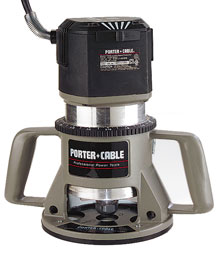
This classic router is still a great choice for heavy use in a router table. It's not quite as convenient as the Milwaukee, but easier to set up than most plunge routers. There's no micro-adjust knob. You change the height of a bit by rotating the router motor, which is basically a coarse adjustment. For fine-tuning bit height you simply give the motor a little nudge. All this involves constantly turning a wing nut that tightens the motor to the base. We wish this nut was a quick-release clamp instead.
The sliding speed control reads in real rpms, which is handy (other machines have arbitrary scales that require a chart to translate). However, the speed control is located on top of the router, along with the On/Off switch. Both are very difficult to see when the router is hanging under a table. The hole in the base is huge (4-1/2 in. diameter).
Source:
Porter-Cable, (800) 487-8665, www.porter-cable.com
Bosch 1619 EVS $310
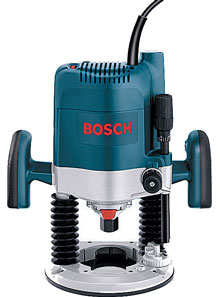
The Bosch is easier to set up and adjust in a router table than most other plunge routers. The hole in the base is exceptionally large (3-3/4-in. diameter), making bit changes easier. You can override the spring-loaded plunge mechanism and make both coarse and fine adjustments in the height of the bit. On the downside for router table use, the speed control is on top of the motor and is difficult to see. The micro-adjust handle is inconveniently short. The depth-of-cut scale is clearly legible and can be zeroed. A dust shroud is included.
Source:
Bosch Power Tools, (877) 267-2499, www.boschtools.com
Craftsman 26835 $250
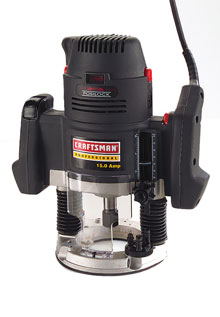
The Craftsman comes with a micro-adjust knob and has a decent depth-of-cut scale but you can't zero it out. No dust shroud is available. An easy-to-use spindle lock disables the On/Off switch—a good safety feature. There's a chance of confusing the On/Off switch with the plunge lock, as they're both built into the handles. The hole in the base is 2-1/2-in. diameter. Craftsman does not recommend using a bit larger than 2-1/2-in. diameter on this machine.
Source:
Craftsman, (800) 377-7414, www.sears.com
DeWalt DW625 $230

For a standard plunge router, the DeWalt is about as good as it gets. It's got loads of power and many of the key features that make router table work easier. The speed dial and On/Off switch are quite good. A micro-adjust knob is a $25 accessory. The opening in the base is an average size (2-1/2 in. diameter).
This router really shines at hand-held work. The handles are well-placed, giving it a conveniently low center of gravity. It's got a clearly legible scale that can easily be zeroed. The cursor line is very thick, however, making it difficult to read precisely. The router comes with a dust shroud.
Source:
DeWalt, (800) 433-9258, www.dewalt.com
Fein RT-1800 $300
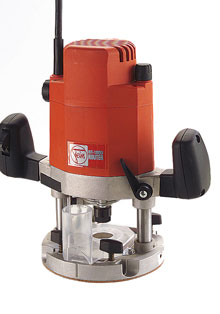
This router is well-balanced. It's easy to guide for hand-held work. The depth-of-cut scale is easy to read and can be zeroed. It comes with a dust shroud and a small micro-adjust knob (a larger knob that's recommended for router table work is $20 extra). The speed control is mounted on top of the motor and is hard to see under a router table. The base has a 3-in.-diameter hole.
Source:
Fein Power Tools, (800) 441-9878, www.feinus.com
Freud FT2000EP $185
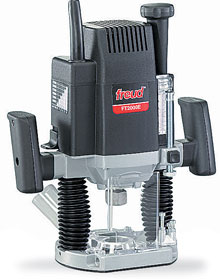
He Freud has three good router table features: a micro-adjust knob is included, the On/Off switch is quite accessible and the speed control is easy to see. The opening on the base is only 2-3/8-in. diameter, though. It's a mixed bag for hand-held work. The depth-of-cut system can't be zeroed (see “Plunge Routers Off the Table,“ page 64) and the scale is hard to read, but you do get a dust shield.
Source:
Freud USA, (800) 334-4107, www.freud-tools.com
Hitachi M12V $160

The Hitachi is a good, no-frills machine. In the router table, the On/Off switch and speed control are easy to see and use. A micro-adjust knob (highly recommended) is a $25 accessory. The hole in the base is very small (2-in. diameter). For hand-held use, the depth-of-cut scale is clearly legible and can be zeroed, but a dust shroud isn't available.
Source:
Hitachi Power Tools, (800) 829-4752, www.hitachi.com
Makita 3612C $250
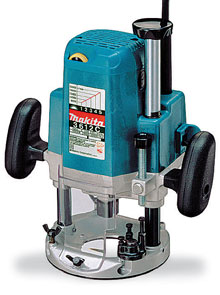
This is the only machine with a brake, a feature we'd like to see on more routers. This router's small size makes it very comfortable to use for hand-held cuts. It comes with a micro-adjust knob. The speed control is very easy to see under a router table. The depth-of-cut scale is difficult to read and can't be zeroed. The dust shroud is a $23 accessory. The hole size in the base is 2-3/8-in. diameter.
Source:
Makita USA, (800) 462-5482, www.makitatools.com
Porter-Cable 7539 $320
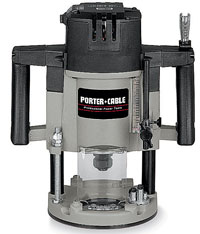
This is one heck of a powerful plunge router, but adjusting it in a router table can be awkward. Thank goodness it has a large hole in the base (3-1/2-in. diameter) for big bits, but adding the micro-adjust knob (a $25 accessory) involves removing some small parts that you'll need to reassemble for hand-held work. In a table, you must use two hands to adjust the bit height: one to turn the handle and the other to depress the plunge-lock lever. The speed control is on top of the motor where it's difficult to see upside down. The handles span 11-1/4 in. It may be difficult to fit this router through some router table openings.Every other 3-hp router weighs a hefty 12 to 13 lbs., but this machine tops the scale at 17 lbs. It has a decent depth-of-cut scale that can be zeroed. A dust shroud is a $45 accessory.
Source:
Porter-Cable, (800) 487-8665, www.porter-cable.com
Triton TRC001 $320
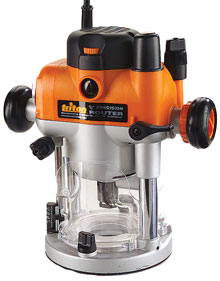
This unusual machine stands head and shoulders above the plunge-router pack as the easiest to set up and adjust in a router table. It's got plenty of power, as well. To change bits, you raise the collet above the surface of the table. No other plunge router can do this, and it means you don't have to remove the router from the table to swap cutters. The Triton is also the only plunge router with a rack-and-pinion system for raising and lowering the motor. This system gives you both a coarse adjustment and a fine adjustment micro-dial. The speed control is easy to see under the table. A dust shroud is included. The hole in the base is 3-1/8-in. diameter. Unfortunately, the Triton is not equally good for hand-held plunge routing. It's top-heavy and tippy. Its handles are mounted too high for easy control. The depth-of-cut system is easy to read but can't be zeroed.
Source:
Triton, (888) 874-8661, www.tritonwoodworking.com
Here are some supplies and tools we find essential in our everyday work around the shop. We may receive a commission from sales referred by our links; however, we have carefully selected these products for their usefulness and quality.



